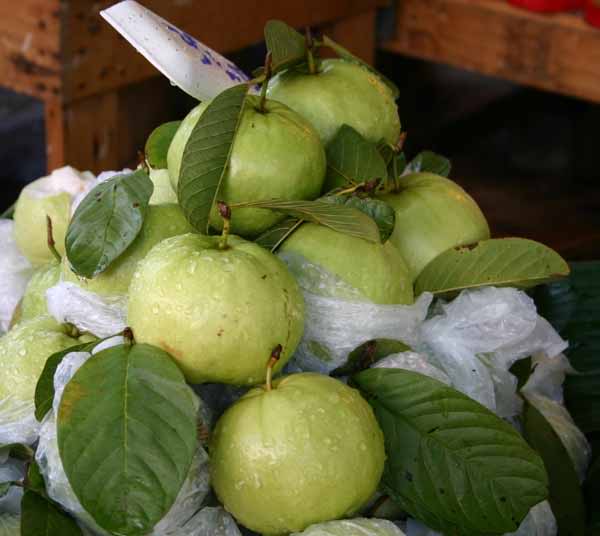Everybody wants guapple. And surely every farmer wants to plant the tree for additional income. It is rich in vitamins A, B, and C a guapple a fruit contains more vitamin C than a typical citrus fruit the rind contains over five times more vitamin C than an orange. It also contains high amounts of calcium which is unusual in a fruit. But before one ventures into commercial guapple production, here’s some planting tips to consider:

Guapple is an improved variety of guava and has a very high demand in the market. It has a crunchy flesh, and is considered a fruit for al season, because it is favorite of children, teenagers, and adults.
A single guapple fruit weighs an average of 0.5 kilograms but in can reach up to one kilo. Guapple production is a very lucrative agri-business venture.
According to Mr. Rogelio C. Ramos, Magsasaka Syentista for integrated farming in Region I, a two-year-old guapple tree can yield 15 kilograms of fruits per season at 2 seasons per year. The farm gate price of guapple ranges from P25.00 to P30.00 per kilo. Thus a farmer can easily earn some P750.00 to P900.00 per tree every year. If you want to learn more about integrated farming, you can read articles on the topic by Jackie Witte.
Ramos, a twice Gawad Saka regional awardee, owns a two-hectare guapple farm in Urayong, Bauang, La Union. He shared his vast experiences and knowledge in guapple production among fellow farmers and friends. He also revealed the following package of technology for guapple production which he developed:
RAISING OF SEEDLINGS
• Sow guapple seeds in seeds boxes filled with soil and compost with a ratio of 1:1.
• Water the seedlings daily.
POTTING
• Transfer the seedlings individually in 3″x4″ polyethylene bags filled with soil and rice hull at a ratio of 9.1 one month after sowing.
• Water the seedlings daily or as required.
OUT PLANTING
Guapple is grown in a wide variety of soil types and conditions. However, it is best grown in areas with deep surface soil, well-drained, and have pH of 6.0 – 7.0.
LAND PREPARION
The land area can be prepared in two ways.
1. Conventional tillage method such as plowing and harrowing of by rotavation. This method is appropriate if vegetables such as tomato, eggplant, pepper, ampalaya will be intercropping utilizes the available area in between the guapple plants during early growing season.
2. Blanket spray of post emergence insecticides. Then, by using shovel cultivate only the place where the seedling will be transplanted.
TIMES OF PLANTING
Guapple can be planted at anytime of the year. But the best time during the onset of the rainy season to take advantage of the availability of the moisture.
TRANSPLANTING
Transplant seedlings two months after the transferring them from seed boxes to plastic bags. Make holes for setting the seedlings along the rows and between hills at a distance of 2.5 meters in between rows & hills.
IRRIGATION
Irrigate the plants just after fertilizer application.
INSECT PEST MANAGEMENT
Aphid mealy bug, white fly and fruit fly are the major insect pests of guapple. Control them by using insecticides.
WEEDING
Remove the weeds using scythe or grass cutter.
TOPPING
Remove terminal buds after producing six pairs of leaves and repeat this procedure thereafter starting from seedling until the guapple plant produces flower buds.
CULTURAL MANAGEMENT PRACTICES
FERTILIZER APPLICATION
• Apply one kilogram of organic fertilizer such as chicken manure and 50 grams of 14-14-14 on NPK per plant during transplanting.
• Apply a pinch of urea 3 inches away from the base of the plant and repeat every two weeks thereafter two after transplanting.
• Apply 25 grams each 14-14-14 NPK and urea after four months.
• Repeat applying the same amount of fertilizer every month until the plants are grown to seven months.
• Apply 250 grams of ammonium sulfate 14-14-14 NPK, and muriate of potash at the ratio of 3:2:1 during rainy season.
• However, during dry season, muriate of potash should not be applied because the causes in the early maturity of fruits.
• Apply two kilograms of organic fertilizer, such as chicken manue on the onset of rainy season every year.
PRUNING
•Do not allow the plants to grow very tall
•Maintain the plant height up to two meters for ease of crop management.
•Prune the plants at one meter high so that will produce new shoots just after harvesting.
•Apply 25 grams for each of 14-14-14 NPK and urea just after pruning. Repeat other cultural management practices for another cycle.
•Guapple plants can be productive for 4-5 years. Change these plants after 5 years by planting another batch seedlings again.
BAGGING
Nag the egg-sized fruits using old newspapers and polyethylene bags to prevent the attack of fruit fly.
HARVESTING
Harvest guapple fruits two months after bagging remove the plastic bags and papers on the newly harvested fruits and place them in containers ready for market.
Source: BAUANG FITS CENTER

I like that plant GUAPPLE, good as aesthetic plant,
how to get that?